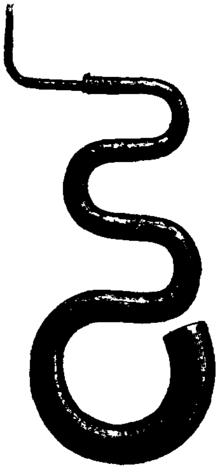Tenor recorder
The tenor recorder is a member of the recorder family. It has the same form as a soprano (or descant) recorder and an alto (or treble) recorder, but it produces a lower sound than either; a still lower sound is produced by the bass recorder and great bass recorder.
The tenor recorder, like the soprano recorder, is tuned in C, but is pitched an octave lower. Because of its larger size, many tenors have keys to make it easier to play the lowest C and C♯, and occasionally D and D♯.
In modern notation, the tenor is written at sounding pitch, unlike most of the other recorder sizes, which (except sometimes the alto) are written an octave lower or higher than they sound (Lasocki 2001).
History
In the Baroque there was a notable lack of the tenor recorder in C, which featured in consort music of the Renaissance, and which forms an important part of the modern recorder playing movement. Instead there existed an alto recorder in D, or "Voiceflute", which was said to be the instrument closest in character to the human voice. In the 18th century, in German-speaking countries, the tenor recorder was named Quartflöte (fourth flute), after the interval it forms below the ordinary recorder (alto) in F. Confusingly, the same name was used for the soprano recorder in C, apparently because it forms the same interval above the alto in G. At the same time, the English and French equivalents, "fourth flute" and "flute du quatre", meant a recorder a fourth higher than the alto in F—that is, an instrument with B♭ as its lowest note (Lasocki 2001).
More recently the tenor recorder has become the subject of experimentation into modern "harmonic" recorders, so called because of their in-tune harmonics. Models such as the Helder, Modern Alto, and Comfort Tenor have been manufactured by the German recorder manufacturer Mollenhauer (Mollenhauer Recorders 2020).
Repertoire
Notably, the soprano recorder has the largest work for a solo wind instrument in European history, Der Fluyten Lust-hof composed by Jacob van Eyck (Wind 1984, 178). Much of the repertoire of the Baroque traverso is commonly adapted onto the tenor recorder. Additionally the tenor recorder has been included in many contemporary ensemble works, such as Hindemith: Abendkonzert aus Plöner Musiktag for SAT ensemble, and the "Music for Recorders" as edited by Benjamin Britten, among other contemporary works.
References
- Lasocki, David. 2001. "Recorder". The New Grove Dictionary of Music and Musicians, second edition, edited by Stanley Sadie and John Tyrrell. London: Macmillan Publishers.
- Mollenhauer Recorders. 2020. "Useful Information: Recorder Designs". Mollenhauer.com (accessed 10 April 2020).
- Wind, Thiemo. 1984. "Der Fluyten Lust-hof: Erste vollstandig kommentierte Gesamtausgabe, herausgegeben von Winfried Michel und Hermien Teske (Winterthur, Amadeus Verlag, 1984)". Tijdschrift van de Vereniging voor Nederlandse Muziekgeschiedenis 34, No. 2:178–83 doi:10.2307/939015 JSTOR 939015 ISSN 0042-3874
Further reading
- Alker, Hugo. 1963. "The Tenor Recorder: Its Development, Special Characteristics and Repertoire", with additions and amendments by Edgar Hunt. The Consort no. 20 (July): 166–73.
- Baines, Anthony C. 1967. Woodwind Instruments and Their History, third edition, with a foreword by Sir Adrian Boult. London: Faber and Faber. Reprinted with corrections, 1977. This edition reissued, Mineola, New York: Dover Publications, Inc., 1991, and reprinted again in 2012. ISBN 978-0-486-26885-9.
- Bowman, Peter. 1995. "The Birth of a Truly Contemporary Recorder". Recorder Magazine 15, No. 4 (November): 126–27.
- Praetorius, Michael. 1619a. Syntagmatis Musici Michaelis Praetorii C. Tomus Secundus De Organographia. Wolfenbüttel: Elias Holwein, in Verlegung des Autoris.
- Praetorius, Michael. 1619b. Syntagmatis Musici Michaelis Praetorii C. Tomus Tertius. Wolfenbüttel: Elias Holwein.
- Rose, Pete. 1996. "A New Recorder for New Music". American Recorder 37, No. 4 (September): 18–20.
- Sachs, Curt. 1913. Real-Lexikon der Musikinstrumente, zugleich ein Polyglossar für das gesamte Instrumentengebiet. Berlin: Julius Bard.
